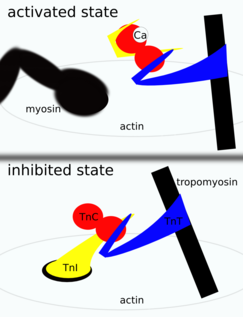Troponin
Troponin[edit | edit source]
Troponin is a complex of three regulatory proteins (troponin C, troponin I, and troponin T) that is integral to muscle contraction in skeletal and cardiac muscle, but not smooth muscle. Troponin is attached to the protein tropomyosin and lies within the groove between actin filaments in muscle tissue.
Structure[edit | edit source]
Troponin is composed of three subunits:
- Troponin C (TnC): This subunit binds calcium ions and is responsible for the conformational change that allows muscle contraction to occur. It is similar to calmodulin in structure and function.
- Troponin I (TnI): This subunit inhibits actin-myosin interactions, thus preventing muscle contraction in the absence of calcium.
- Troponin T (TnT): This subunit binds the troponin complex to tropomyosin, anchoring it to the actin filament.
Function[edit | edit source]
Troponin plays a crucial role in the regulation of muscle contraction. When calcium ions are released from the sarcoplasmic reticulum, they bind to troponin C, causing a conformational change in the troponin complex. This change moves tropomyosin away from the actin binding sites, allowing myosin heads to bind to actin and initiate contraction.
Clinical Significance[edit | edit source]
Troponin levels are measured in the blood to diagnose myocardial infarction (heart attack). Elevated levels of cardiac-specific troponins (cTnI and cTnT) indicate damage to the heart muscle. These biomarkers are more specific and sensitive than previous markers such as creatine kinase (CK-MB).
Related Pages[edit | edit source]
References[edit | edit source]
- Marieb, E. N., & Hoehn, K. (2018). Human Anatomy & Physiology. Pearson Education.
- "Troponin." (2023). In Wikipedia, The Free Encyclopedia. Retrieved from https://en.wikipedia.org/wiki/Troponin
Troponin[edit | edit source]
Search WikiMD
Ad.Tired of being Overweight? Try W8MD's physician weight loss program.
Semaglutide (Ozempic / Wegovy and Tirzepatide (Mounjaro / Zepbound) available.
Advertise on WikiMD
|
WikiMD's Wellness Encyclopedia |
| Let Food Be Thy Medicine Medicine Thy Food - Hippocrates |
Translate this page: - East Asian
中文,
日本,
한국어,
South Asian
हिन्दी,
தமிழ்,
తెలుగు,
Urdu,
ಕನ್ನಡ,
Southeast Asian
Indonesian,
Vietnamese,
Thai,
မြန်မာဘာသာ,
বাংলা
European
español,
Deutsch,
français,
Greek,
português do Brasil,
polski,
română,
русский,
Nederlands,
norsk,
svenska,
suomi,
Italian
Middle Eastern & African
عربى,
Turkish,
Persian,
Hebrew,
Afrikaans,
isiZulu,
Kiswahili,
Other
Bulgarian,
Hungarian,
Czech,
Swedish,
മലയാളം,
मराठी,
ਪੰਜਾਬੀ,
ગુજરાતી,
Portuguese,
Ukrainian
Medical Disclaimer: WikiMD is not a substitute for professional medical advice. The information on WikiMD is provided as an information resource only, may be incorrect, outdated or misleading, and is not to be used or relied on for any diagnostic or treatment purposes. Please consult your health care provider before making any healthcare decisions or for guidance about a specific medical condition. WikiMD expressly disclaims responsibility, and shall have no liability, for any damages, loss, injury, or liability whatsoever suffered as a result of your reliance on the information contained in this site. By visiting this site you agree to the foregoing terms and conditions, which may from time to time be changed or supplemented by WikiMD. If you do not agree to the foregoing terms and conditions, you should not enter or use this site. See full disclaimer.
Credits:Most images are courtesy of Wikimedia commons, and templates, categories Wikipedia, licensed under CC BY SA or similar.
Contributors: Prab R. Tumpati, MD




